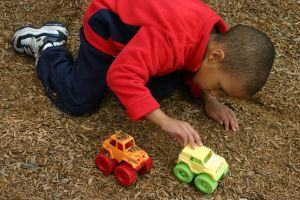Between the ages of five and six, children will start to lose a little bit of their self-centeredness and be more interested in group activities. Kids will want to be with others, in sports, school activities, or just sharing toys. Because kids are now surrounded with other kids their age on a more regular basis, they will soon discover the types of personalities that they can get along with.
Children this age typically enter first grade. A little more rigid than kindergarten, children will become more involved in school subjects. Plays will be put on from time to time, as well as storytelling and show and tell. Simple worksheets filled with basic math problems might get distributed and children will be writing more than they ever have.
The best types of activities for the first grader include simple things. Soft toys that cluttered their rooms as toddlers are no longer in sight. Things such as dry-erase boards, puzzles, board games, and beginning sports equipment will be introduced. Your “baby” is growing up even faster now. What are the best activities for these fast growing children? The following list will suggest activities that five and six-year-olds can enjoy.
Learning About the Community
By bringing your child out into the community, he or she can understand what happens out in the real world. Getting kids involved with things such as youth groups, or adopting an animal at a zoo, gives them a sense of maturity. By introducing kids to people such as nurses, zookeepers or firemen, they can observe what people do out in the real world and may even develop what types of careers they may want as well.
Recognizing States and Countries of the World
Sitting down with your child and looking at a globe or a map will give them an idea of how big the world really is. Parents can point out where they live on a map, in order to show their kids where they are exactly in relation to other cities and states. By six years old, your child should have their home address and home phone number memorized. If you don't have a landline, have them memorize the phone number of at least one of their parents. This isn't just important for their development, but for their safety. If they ever get separated from you, it's good for them to know where they live and how to contact you.
Learning About the Family’s Culture
There are so many heritages and cultures in the world. By introducing your child to a little of the family’s background and ancestry, he or she can learn a little something more about their family and themselves. Bringing out a family tree can be fascinating to a young child as well. Help them understand the concept of distant ancestors, and how their family goes beyond just grandparents, aunts, and uncles.
Age-appropriate Video Games
This may not seem like the best activity, but there are some educational video games for young children. Some may teach lessons on math or even learning a new language. Kids can even partner up with other kids so that they can help each other.
There's nothing wrong with your child playing video games for fun, either. There's often a stereotype that goes around of the lazy kid who spends all of their time on the computer or in front of the TV. In reality, video games are a great way to relieve stress, improve reflexes, and explore creativity. Make sure you check any video game that you purchase for your child. At this age, children should only be playing games that are rated E or, depending on the child, E10+.
Simply Playing with Other Kids
Simple and fun. By encouraging your child to play nicely with others, he or she will meet new kids and develop some long and lasting friendships. Playing with other kids involves learning how to share and to let go of that self-centeredness. See if you can set up play-dates between your kid and other kids at their school or in your neighborhood. Take them to a local park so they can interact with other children.
This is also a great way to potentially spot any social issues arising in your child. If your child is struggling to interact properly with other children, it could be an indication of a deeper problem. Give them some time; if it doesn't improve, consult their pediatrician for professional input.
The image featured at the top of this post is ©ID 1058750 © anissat | freeimages.
